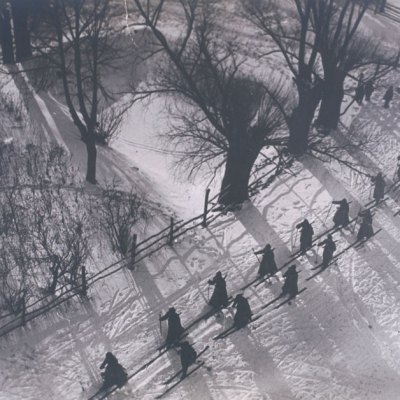The German film-maker was a prolific photographer in the 1970s and ’80s – he claims to have taken more than 12,000 photographs – often on location and sometimes of his cast and crew. In recent years he has recovered some of the Polaroids he gave away to friends, and scanned, reprinted and exhibited them.
What is it like to revisit photographs you took several decades ago?
I have a hard time seeing these pictures as ‘old’ or ‘new’. I see them from scratch, that’s for sure, decades later, after having forgotten them entirely. I can barely relate to the guy who took them. I can see he took them in the present, because he was very much into the present tense, he was never nostalgic or into the past. That ‘He’ is ‘Me’ now, trying to decipher the young man I used to be, and I see things that I certainly didn’t think about at the time. I see a young man who took photos very impulsively. I still recognise the impulses, and it’s a pleasure to see that some have remained the same. Some of course got into my body, so I sometimes wonder who took those pictures. Was it my body – my thumbs and hands, my eyes – or was it a conscious act? It’s always a state of bliss to take a picture and not to have to know too much about why or how: just by curiosity or by impulse, well, and by some sort of body language. Photographs are very much body language, especially Polaroids.
Is the impulse to take a photograph completely different from making a film?
I realise that young man was very much driven by spontaneous impulses and not at all an intellectual photographer. I’m relieved to see that even in the beginning I never really trusted my intellectual capacity so much as I trusted my eyes and my gut feelings. It’s a relief that I haven’t changed that much.
When I’m making a movie, on the set, sure, I have a story to tell and sometimes even a script (not always, but sometimes), but every set up and every frame can still be impulsive and there is lots of leeway to do things from your guts instead of from your brains.
NY breakfast (1973), Wim Wenders. Courtesy the artist and Blain|Southern; © Wim Wenders

What is so special about Polaroids?
Cameras have a propensity to dictate the style of the products that you take with them. Polaroids are very obviously dictating the framing. The SX-70 for instance was a square format, and never in my wildest dreams did I think I would take square pictures, because it goes against all my instincts. But then I got used to the SX-70, against all odds, and got used to putting things smack in the middle. Whatever picture you take with that camera, your subject (or object?) has to be in the middle. The cherry there [points to picture] is in the middle. It’s a whole different aesthetic process to put something into the middle of the picture than slightly to the side. In a movie I would never put a person into the middle of the frame, because you don’t have a square image.
Were you thinking of Andy Warhol’s Campbell’s soup cans when you photographed the soup cans in the store?
Did I think of Andy Warhol?! Sure. There were no Campbell’s soups in Germany, so going to a supermarket in America for the first time was the discovery of the real object, the actual red and white Campbell’s soup. I was excited it really existed. I didn’t buy any, however. I just stared at the thing. You know they make those soups in Paris, Texas, believe it or not. I found that out 10 years later.
Campbell Soups, New York (1975), Wim Wenders. Courtesy the artist and Blain|Southern; © Wim Wenders

Your Polaroids often seem more influenced by paintings than films (even your own).
Because I learned more about framing from painters than from photographers. Because the act of framing is so much more decisive in a painting. In photography, I quite often have the feeling it’s a random process. Not so much in mine – framing is extremely important for me. But in paintings framing is never arbitrary.
What do you mean by framing being random in photography?
In movies, there are many directors who don’t give a flying fuck about the framing. They’ll let their DOPs do the framing and every DOP has a certain way of framing – so that director would make a different kind of frame with another cinematographer. I was instructed by painting when I grew up. That was my school of seeing. The framing I learned was from painters, from Vermeer, Rembrandt, Caspar David Friedrich or God knows who. In photography when you take your first picture you realise – wait a minute, I can do it this way, I can put the person in the middle, I can take it without the person, I can have the horizon on top, in the middle or at the bottom…
You never look at a painting and think, ‘What a strange framing’. It’s always a given and in photography it’s very rarely such a given. There are some photographers who know exactly what they’re doing and their framing is always as impeccable as in any Rembrandt. But overall, I feel, in photography the necessity of framing slowly gets lost – and the more people are getting used to taking pictures with their phones, the less they actually care about the framing.
LIquor Store, San Francisco (1973), Wim Wenders. Courtesy the artist and Blain|Southern; © Wim Wenders

You’ve previously described photography as a way to stop seeing something. Could you explain that further?
Seeing can also be a disease. There’s too much to see, the world is too full of stuff. And then, a photograph is always an act of exorcising something, if you know it consciously or not. It’s also a scary process. Because it produces something that lasts, it shifts the random process of looking around into something lasting. And then either there is a certain necessity in it and a certain truth, or there isn’t.
Do you sometimes see things in these photographs that you didn’t see at the time?
When I was given an SX-70 for the very first time, I took a picture of what I had in front of me, which was that breakfast table with cottage cheese and the cherry on top of it. Then I said, ‘Let me just run out,’ and walked out of the hotel and sat in the camera car that we were going to use in our movie [Alice in the Cities]. So I took that picture through the windshield. At the time all these American cars had tinted windows which create this strange effect – a strip of colour at the top of your view – so I only looked at that colour dissolve on the windshield and didn’t even pay attention to any of the rest. I was eager for the experience and not at all aware of what was in the shot: the old VW there, the station wagon, the grocery store, I didn’t see any of it, yet today it’s such a time capsule, and against all odds it has turned into something very solid.
Through the windshield, NY (1973), Wim Wenders. Courtesy the artist and Blain|Southern; © Wim Wenders

Does the way in which the Polaroids have aged also affect your memory of the past?
You can almost tell by looking at a picture – not by studying the details, but the surface of the picture – when it was taken. Remember those awful black and white photographs with the ‘toothed’ jagged edges? Well, if you see one, you know it’s from the ’50s. I hated them when I was a kid – any drugstore would just produce these prints with the awful borders. That alone was a reason to have a dark room. You see the age of the photograph in the realm of colour or in the contrast of the picture, but also the way the edge is produced. The ’60s were big on borderless photographs. At the time, you were so much involved in that period that you didn’t see what was specific to it – it was just the present tense.
Can you tell me about some of the new prints you’ve made?
We produced a small series of enlargements from the Polaroids. At first, I thought it was a bit of a sacrilege, because at the time it would have never crossed my mind to blow them up. They were so much everyday objects. And they weren’t negatives, they were unique little ‘things’. But then again, now, I’m really pleased to see that the pictures have survived the operation, especially the Liquor Store. With some of them, I was just curious. And with a couple of them, I decided that the new prints didn’t suit them.
Alice in Instant Wonderland (1973), Wim Wenders. Courtesy the artist and Blain|Southern; © Wim Wenders

You’ve mentioned people taking photographs on their phones. What do you think those photos will look like to us in the future?
Chances are no one is going to see them. No one is going to be able to read that format any more unless you migrate your iPhone pictures, maybe print them. Have you ever done that? Probably not. It’s an interesting fact that now that we take so many more pictures than ever before, we don’t print them any more. Those Polaroids had that very extraordinary property that they were an instant object. It is a strange little science-fiction period in the history of photography when you didn’t have a negative or a file, you had ‘the thing’. It was also dangerous, because you would almost necessarily give it away. Well, I did, two out of three.
How did you recover some of the Polaroids you gave away? And what did you keep?
Basically, I kept all the ones that somehow stayed with me in cigar boxes. They survived countless moves and travelled several times back and forth between Europe and America. The others? Some I retrieved from friends. My long-term editor, for instance, who died a few years ago. His wife said, we’ve got all these things, what do we do with them? I said, wait a minute, don’t throw anything away, and she gave it all to the foundation [the Wim Wenders Foundation]. A few of my old Polaroids came back to me this way, because I gave a whole lot to him. Of course they don’t belong to me any more, they now belong to the foundation. It’s a good thing to be reminded that photography isn’t all that much about ‘ownership’. I remember how easily I gave them away – I didn’t feel any regret, even if it was a unique piece. Today, I don’t know. You can ‘share’ any picture and immediately send it. But that doesn’t mean a thing.
This interview took place at Blain|Southern, London, in March 2018. ‘Wim Wenders: Instant Stories’ is at C/O Berlin until 22 September.



